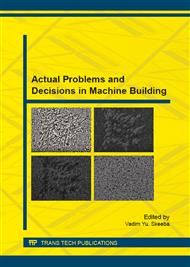[1]
V.I. Moshchenok, Modern classification of hardness measurement techniques, Avtomobilny transport. 25 (2010) 129-132. (in Russian).
Google Scholar
[2]
S.I. Bulychev, V.P. Alekhin, Material Testing by Continuous Indentation of an Indenter, Mashinostroenie, Moscow, 1990. (in Russian).
Google Scholar
[3]
P.M. Ogar, V.A. Tarasov, Kinetic Indentation Application to Determine Contact Characteristics of Sphere and Elastoplastic Half-Space, Advanced Materials Research. 664 (2013) 625-631.
DOI: 10.4028/www.scientific.net/amr.664.625
Google Scholar
[4]
W.C. Oliver, G.M. Pharr, An improved technique for determining hardness and elastic modulus using load and displacement sensing indentation experiments, Journal of Materials Research. 7 (1992) 1564–1583.
DOI: 10.1557/jmr.1992.1564
Google Scholar
[5]
P.M. Ogar, V.A. Tarasov, D.B. Gorokhov, The Correction Factor in Elastic Modulus Determining by Indentation, Advanced Materials Research. 887 - 888 (2014) 997-1000.
DOI: 10.4028/www.scientific.net/amr.887-888.997
Google Scholar
[6]
Yu.V. Milman, K.E. Grinkevich, P.V. Mordel, The principle of power hardness under instrumental indentation, Deformation and fracture of materials. 1 (2013) 2-9.
Google Scholar
[7]
P.M. Ogar, V.A. Tarasov, A.V. Turchenko, I.B. Fedorov, Energy density of material's plastic displacement under a spherical indentation, Proceedings of the Bratsk State University. Series: Natural and engineering sciences. 3 (2012).
Google Scholar
[8]
I.B. Fedorov, The volume of displaced material in spherical indentation, Proceedings of the Bratsk State University. Series: Natural and engineering sciences. 1 (2014) 207-211. (in Russian).
Google Scholar
[9]
P.M. Ogar, V.A. Tarasov, Influence of a form of axisymmetric load on elastic plastic half-space's stress-strain state, Systems. Methods. Technologies. 5 (2010) 14-20. (in Russian).
Google Scholar
[10]
P.M. Ogar, V.A. Tarasov, D.B. Gorokhov. Energy concept of hardness by the kinetic sphere indentation, Advanced Materials Research. 1061-1062 (2015) 579-583.
DOI: 10.4028/www.scientific.net/amr.1061-1062.579
Google Scholar
[11]
J. -M. Collin, G. Mauvoisin, P. Pilvin, Materials characterization by instrumented indentation using two different approache, Materials and Dising. 31 (2010) 636-640.
DOI: 10.1016/j.matdes.2009.05.043
Google Scholar
[12]
X. Hernot, O. Bartier, Y. Bekouche, R. El. Abdi, G. Mauvoisin, Influence of penetration depth and mechanical properties of contact radius determination for spherical indentation, International Journal of Solids and Structures. 43 (2006).
DOI: 10.1016/j.ijsolstr.2005.06.007
Google Scholar
[13]
H. Lee, J.H. Lee, G.M. Pharr, A numerical approach to sphericalindentation techniques for material property evaluation, J. Mech. Phys. Solids 53 (2005) 2037-(2069).
DOI: 10.1016/j.jmps.2005.04.007
Google Scholar
[14]
B. Taljat, G. M. Pharr, Development of pile-up during spherical indentation of elastic–plastic solids, International Journal of Solids and Structures. 41 (2004) 3891–3904.
DOI: 10.1016/j.ijsolstr.2004.02.033
Google Scholar
[15]
A.N. Bolotov, O.V. Sutyagin, M.V. Vasil'yev The study of elastic-plastic deformation of the metal contact in relation to the processes of frictional interaction, Izvestiya Samar. nauch. tsentra RAN. 13 (2011) 917-981. (in Russian).
Google Scholar
[15]
W.C. Guo, G. Rauchs, W.H. Zhang, J.P. Ponthot, Influence of friction in material characterization in microindentation measurement, Journal of Computational and Applied Mathematics. 234 (2010) 2183-2192.
DOI: 10.1016/j.cam.2009.08.072
Google Scholar


